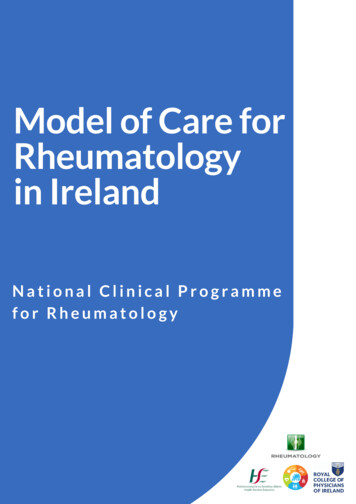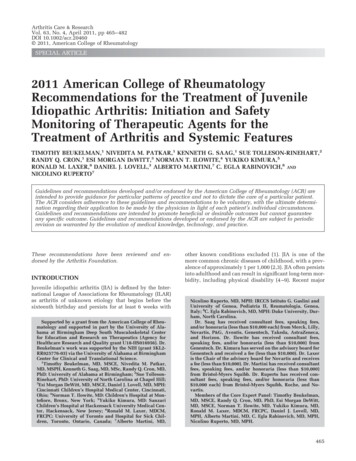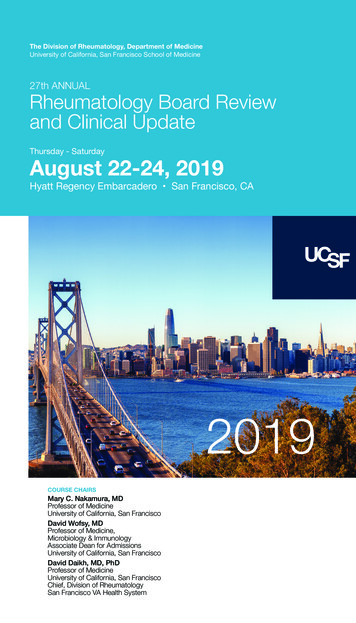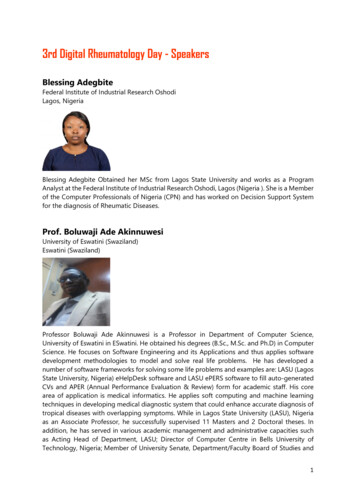
Transcription
Model of Care forRheumatologyin IrelandNational Clinical Programmefor Rheumatology
ContentsContributors and StakeholdersiAbbreviationsiiiGlossaryivClinical Leads ForewordvExecutive Summaryvi1. Introduction and Background11.1 Overarching Aim of the Programme21.2 Programme Solutions32. Rheumatic and Musculoskeletal disorders62.1 Definitions and Epidemiology62.2 The need for a population health approach93. Model of Care103.1 Rationale for Model Selection103.2 Key Elements of Model of Care114. Care Pathway development135. Rheumatology Clinical Networks145.1 Structure of Rheumatology Clinical Networks155.2 Clinical and Corporate Governance16Core principles and elements of RhCNs175.3 Critical Success Factors for Implementation and Functioning of RhCN185.4 Community Health Organisations (CHOs)195.5 Self-Management Programmes205.5.1 Arthritis self-management in Ireland215.5.2 Delivery of a Self-Management Programme226. Vocational Rehabilitation237. RhCN Service Delivery requirements267.1 RhCN requirements267.2 Facilities and Staffing267.3. Secondary Hospital Care287.4. Tertiary Rheumatic and Musculoskeletal Diseases Units288. Paediatric Rheumatology299. Governance349.1 Project group359.2 Clinical Advisory Group359.3 Roles and Responsibilities359.4 Training379.5 Key Performance Indicators, Audit and Research399.6 Education and Research40
9.7 Risk Management419.8 Performance Management4210. Potential Impact4310.1 Value4310.2 Information Technology4310.3 Implementation Timeline44References45Appendix 150Chronic Care Model (Wagner, 1998)Appendix 25051Rheumatic Musculoskeletal Disease Unit, Our Lady’s Hospice and Care Services – A TertiaryReferral Rheumatology Facility51ReferencesAppendix 3Key Performance indicators of the National MSK Physiotherapy Triage InitiativeAppendix 4Advanced Physiotherapy Musculoskeletal Training for PhysiotherapistsAppendix 5Rheumatology Model of Care Flow56575759596161List of FiguresFigure 1. Population Health approach as it relates to MSK health (Taylor, 2007, HSE, 2008b,Minnock et al., 2012)9Figure 2. Rheumatology outpatient attendances by county 201132Figure 3. The embedding of Clinical Operational Management35Figure 4. Chronic Disease Pyramid of Care Model51Figure 5.Tertiary referral pathways to RMDU, OLH&CS53List of TablesTable 1. Rheumatic and Musculoskeletal disorders6Table 2. Rheumatology Musculoskeletal Medical and Long-term Conditions Framework13Table 3. Rheumatology Clinical Networks Configuration15Table 4. Type and location of current arthritis self-management programmes in Ireland21Table 5. Conditions recognised and actively managed by the paediatric rheumatologyservice29
Contributors and StakeholdersCurrent Project TeamProf David Kane (c),Consultant Rheumatologist and National Clinical LeadDr Maurice Barry,Consultant RheumatologistDr Paul O’Connell,Consultant RheumatologistMs Jennifer Ashton,Physiotherapy LeadMs Ciara Cullen,Physiotherapy LeadMr Gary Killeen,Programme ManagerMs Shona Lee,Nursing LeadMr Brian Lynch,Head of Communications and Advocacy, Arthritis IrelandMs Patricia McQuillan,Professional Development Co-ordinator for Practice NursesMs Jane Brownlee,Occupational Therapy LeadPast Members of Project TeamProf Oliver FitzGerald (c),Consultant Rheumatologist and National Clinical LeadDr John Carey,Consultant RheumatologistDr Robert Coughlan,Consultant RheumatologistDr Trevor Duffy,Consultant RheumatologistDr Catherine Molloy,Consultant RheumatologistDr Barry O’Shea,Consultant RheumatologistDr Donncha O’Gradaigh,Consultant RheumatologistDr David Gibney,GP Lead and National Clinical Programme Clinical Co-leadMs Roisin Breen,Programme ManagerMs Aisling Brennan,Physiotherapy LeadMs Stephanie Casey,Head of Community and Campaigning, Arthritis IrelandMr John Church,CEO, Arthritis IrelandMs Oriel Corcoran,Occupational Therapy LeadMs Majella Doherty,Dietetics Therapy LeadMs Christina Doyle,Assistant Director of Nursing (ADON) and Nursing LeadDr Emer Feely,Consultant in Public Health MedicineMs Isabelle Greene,Dietetics Therapy LeadMs Alma Joyce,Occupational Therapy LeadMs Norelee Kennedy,Physiotherapy LeadMs Fiona McGrehan,Pharmacy LeadMs Sharon Morrow,Programme ManagerMr Nigel Roberts,Podiatry, NUI GalwayMs Aoife Synnott,Occupational Therapy Lead(c) Chairi
Clinical Advisory Group (Nominated by Irish Society for Rheumatology)The Clinical Advisory Group of the National Clinical Programme for Rheumatology is open toall Consultant Rheumatologists who are members of the Irish Society for Rheumatology and ischaired by Dr Alexander Fraser.Primary CareDr Joe Clarke,Clinical LeadDr Brian Murphy,Primary Care ManagerIrish College of General PractitionersHealth and Social Care ProfessionalsIrish Rheumatology Health Professional SocietyIrish Society for RheumatologyNursingMs Joan Gallagher,Chief Policy Analyst, Chief Executive’s Office HSEDr Michael Shannon,Director of Nursing and Midwifery Services, HSEMs Geraldine Shaw,Nursing Lead, Clinical Programmes and Strategy DivisionDirectors of Nursing Reference GroupIrish Rheumatology Nurses ForumHealth and Social Care Professionals (Therapy Professions Committee representing)Association of Occupational Therapists of IrelandDiscipline of Podiatry, NUI GalwayIrish Association of Chiropody and PodiatryIrish Association of Speech and Language TherapistsIrish Nutrition and Dietetics InstituteIrish Orthoptic SocietyIrish Society for Chartered PhysiotherapistsPharmaceutical Society of IrelandSociety of Chiropodists and Podiatrists, IrelandPatient Support GroupArthritis Irelandii
AbbreviationsADLActivities of Daily LivingADONAssistant Director of NursingANPAdvanced Nurse PractitionerASAnkylosing SpondylitisCAGClinical Advisory GroupcDMARDsConventional Disease Modifying Anti-Rheumatic DrugsCHOCommunity Healthcare OrganisationsCNSClinical Nurse SpecialistCPDContinued Professional DevelopmentCSPDClinical Strategy and Programmes DivisionCTComputed TomographyDNADid Not AttendDXADexa ScanEDEmergency DepartmentGIMGeneral Internal MedicineGPGeneral PractitionerHSCPHealth and Social Care ProfessionalsHSEHealth Services ExecutiveICFInternational Classification of Functioning, Disability and HealthICGPIrish College of General PractitionersJIAJuvenile Idiopathic ArthritisKPIKey Performance IndicatorsMDTMultidisciplinary TeamMRIMagnetic Resonance ImageMSDMusculoskeletal DiseaseMSKMusculoskeletalOLCHCOur Lady’s Children’s Hospital CrumlinOPDOutpatient DepartmentPDPPersonal Development PlanningPsAPsoriatic ArthritisRARheumatoid ArthritisRCPIRoyal College of Physicians of IrelandRhCNRheumatology Clinical NetworkRMDURheumatic and MSK Diseases unitSMISelf-Management InterventionSpASpondyloarthropathyTBPMTeam Based Performance ManagementWTEWhole Time Equivalentiii
GlossaryHealth and Social Care Professionals (HSCPs): The HSCP Act 2005 has given statutory basis tothe regulation of 12 professions listed below. Any other health and social care professiondeemed appropriate by the Minister for Health may be added in the future.Clinical BiochemistsDieticiansMedical ScientistsOccupational ychologistsRadiographersSocial Care WorkersSocial WorkersSpeech and LanguageTherapistsClinical Networks are linked groups of professionals and organisations from primary, secondaryand tertiary care, working in a coordinated manner, unconstrained by professional and healthboard boundaries, to ensure equitable provision of high quality, clinically effective servicesCommunity Healthcare Organisations (CHOs) are the new structures in which health care willbe provided in the community. There are nine CHOs to deliver an integrated model of care.This will facilitate a move towards a more integrated health care system, improving services forthe public by providing better and easier access to services, services that are close to wherepeople live, more local decision making and services in which people can have confidence.Performance Indicators are data points used to measure inputs, activities, outputs oroutcomes, and are used to monitor the progress of the programme being reviewed.Interdisciplinary Team Working uses holistic, collaborative and patient focused approach.Effective joint goal setting and review is the cornerstone of the IDTs process.Multidisciplinary Team (MDT) Working involves professionals working independently in order toachieve discipline specific goals, individual team members may not communicate directlywith all other team members in care planningWhole Time Equivalent (WTE) is the equivalent number of combined part time and full-time staffbasis e.g. two staff members both working half time are equivalent to one whole time post.iv
Clinical Leads ForewordThe delivery of care to patients with rheumatic and musculoskeletal (MSK) disorders in Irelandis limited largely by the deficiencies in resources that are currently available in community,primary and secondary care. Delivery is also hampered by the absence on clear guidelinesfor management and the lack of opportunity to develop integrated care pathways acrossprimary and secondary care. Whilst the care delivered in Irish Healthcare is of high quality, theabove deficiencies have led to significant difficulties in accessing care resulting in lengthydelays for assessment, diagnosis and treatment.In this Rheumatic and MSK disorders model of care document, we outline a model which aimsto ensure that the rheumatology patient is seen and assessed and treated by the right person,in the right place and in the timeliest manner. Based on international best practice, we set outboth personnel and infrastructure requirements and we propose an integrated organisationalstructure, based on the hospital networks, which aims to ensure that all patients in Ireland willreceive the same standards of quality care wherever they present within these networks.The model of care outlined is both ambitious and achievable.While some of the costs involved could be met through identifying inefficiencies within thesystem, it is without doubt that investment, both in staffing and in infrastructure, will be requiredto facilitate the implementation of this model of care and in shaping future rheumatologyservices.The model also establishes the foundation on which the National Clinical Programme ClinicalAdvisory Group will develop Care Pathways as outlined in Section 4.The Rheumatology community together with our patients will work closely with all otherstakeholders, including hospital network managers and CHO managers, to ensure that equityin delivery of the model across all 6 hospital networks and 9 CHOs is achieved.Professor David Kane (2015 – current)Professor Oliver FitzGerald (2010 – 2015)v
Executive SummaryRheumatic and Musculoskeletal disorders (RMDs) are a group of more than 200 differentconditions that affect 1 in 4 people of all ages, equivalent to 1.2 million Irish citizens(www.eular.org). It is estimated that 2% of the EU GDP is spent on direct medical care of RMDs.RMDs are the leading cause of disability in Ireland. RMDs cause the single greatestsocioeconomic cost of any disease group due to lost productivity from long-term workabsence and due to the payment of disability benefits.There will be a dramatic increase in the prevalence of RMDs in the next decade due to anincreasing and ageing population. RMDs impede the ability of people to remain economicallyand socially active when becoming older. The social and economic impact of RMDs will beaccentuated by the necessity to maintain the larger, ageing Irish population in work to a laterage.Many RMDs, such as rheumatoid arthritis, have seen major advances in specialistRheumatology treatment in the past decade, effective in preventing joint damage andpatient disability. The need to develop Rheumatology services for the provision of better carefor all patients with RMDs in Ireland is recognised by the Health Service Executive (HSE). In 2010,a National Clinical Programme for Rheumatology (NCPR) was established with the overarchingaim of: “Adopting a chronic disease model of care so as to facilitate a right person, right place,first time approach to patients with RMDs.”The NCPR has now produced this model of care for development of Rheumatology servicesfor the management of Rheumatic and Musculoskeletal Diseases in Ireland (Appendix 5). Themodel of care notes that Ireland has one of the lowest ratios of rheumatologists to populationin the EU and when implemented will bring service provision for RMDs in line with evidencebased practice and international standards of care.The model of care envisages expansion of Rheumatology services in a hub-and-spoke modelof tertiary centres operating within 6 rheumatology networks coterminous with the new hospitalgroups and integrated with primary care services through Community HealthcareOrganisations (CHOs). Given that 1 in 4 Irish people suffer from RMDs the Rheumatology Modelof Care seeks to deliver both specialist services in a tertiary setting and to promote and assistthe development and delivery of primary care services for patients with RMDs in co-ordinationwith the Primary Care Division and National Clinical Advisor and Group Lead for Primary Care.This will provide co-ordinated care and uniform standards of service delivery for patient acrossthe networks and across primary, secondary and tertiary care which is supported by thedevelopment of clear referral protocols, pathways and therapeutic standards. Whenimplemented, this will bring service provision for RMDs in line with evidence-based practiceand best international standards of care.vi
1. Introduction and BackgroundAs the demographic profile in Ireland changes, with increased life expectancy and risingnumbers of the population moving into the middle and older age groups, it is expected thatthe incidence of chronic rheumatological conditions such as arthritis will increase. At the sametime, new medical therapies are radically changing the approach to disease managementand are significantly affecting clinical outcome. With the introduction of improved therapeuticstrategies with cDMARDs and new therapies such as biological medications for inflammatoryarthritis, lasting disease remission is the new therapeutic goal (Emery et al., 2008). Preservationof work status, maintenance of quality of life and prevention of joint damage and disabilityare additional benefits of successful treatment. In rheumatoid arthritis (RA) and otherinflammatory rheumatologic conditions, the time has come for goal-directed managementlike treating RA to an agreed target. This involves monitoring patients closely and titratingmedication in order to achieve the agreed goal of clinical remission or low disease activityusually within the first 6 months of diagnosis, thus reducing costs significantly (Smolen et al.,2010). It is the implementation of this new standard of care, which challenges us all.A previous HSE working group on Arthritis and Allied conditions, convened in 2009*,documented current service provision, examined existing international models of care andundertook a gap analysis of what might be required in order to provide a first-classrheumatology service in Ireland. A report stemming from this work was presented to Dr BarryWhite when he took up his position as Director of the Clinical Strategy and Programmes Division(CSPD) within the HSE in 2009. Responding to this report, dir. White set up a the NCPR with theclear goal of implementing changes within the delivery of care to rheumatology patientswhich would improve the quality of the service, access to the service and also address aspectsof cost.The rheumatic and MSK disorders model of care is a key component of the work of the NCPRand will greatly help to define future service improvements.*not published but all documents available from the NCPR1
1.1 Overarching Aim of the ProgrammeTo develop a chronic disease model of care to facilitate a right person, right place, first timeapproach to patients with rheumatic and MSK disorders.Programme ObjectivesQuality To monitor and reduce mortality associated with rheumatic and MSK disorders with theaid of a rheumatology national register To improve both short-term and long-term outcome measures (e.g. disease activityscores) in patients with rheumatic and MSK diseases using a Treat to Target approach. To reduce physical, psychological and work disability related to rheumatic and MSKdiseases and improve self-managementAccessPrimary care: Ensure engagement regarding rheumatology services within the full national roll out ofprimary care teams and appropriate clinical infrastructure To reduce the overall numbers of patients referred to/requiring routine follow uprheumatology Outpatient Department (OPD) appointments by developing primarycare services integrated assessment teams as appropriateSecondary Care: To reduce waiting lists for all rheumatology referrals to 6 months within 1 year To reduce waiting lists for all rheumatology referrals to 3 months within 2 years Allow fast tracking of early inflammatory arthritis and systemic disease in order toreduce waiting times for such urgent referrals to 2 weeks within 1 yearIntegration between Primary care and Secondary Care: Develop integrated clinics/consultations between primary and secondary careservices managing people with rheumatic and MSK diseases as close to their home aspossible To develop national referral guidelines for all patients with MSK disease within 1 yearValue To identify potential efficiencies and savings within the system e.g. use of Biosimilars,dose reduction strategies, etc. To reduce MSK-related work disability by ensuring appropriate timely interventionsby an MDT By ensuring timely access to services, to reduce the impact of rheumatic diseaserelated joint damage (e.g. reduced requirement for joint replacement surgery)2
Identify and treat patients at risk for osteoporosis, to significantly reduce low-traumafracture occurrence and consequent morbidity and mortality Evaluate the use of biologic medications with the aim of maximising costeffectiveness of hi-tech expenditure1.2 Programme SolutionsQuality Solutions Establish Rheumatology Clinical Networks (RhCNs) that are underpinned by robustclinical and corporate governance structures Develop performance indicators that support the implementation of model of care Develop/agree/implement national clinical guidelines, standards of practice, carepathways with all partners that move from prevention and self-care through to hospitalcare and ensure that the use of primary and secondary care is appropriate to patients’needs Care pathways to include detailed and agreed clinical audit measures and all servicesmust engage in clinical audit To agree and implement disease specific and patient focused quality outcomemeasures To enhance and develop self-management and patient education programmes thatare tailored to particular levels of complexity and risk e.g. those developed by ArthritisIreland To further develop “fracture-liaison” programmes so as to ensure that patients withosteoporosis are identified and treated in a timely manner A national arthritis registry to be established To utilise the International Classification of Functioning, Disability and Health (ICF) as aframework to develop these measures. Activity and participation outcomes to bemeasured in tandem with outcomes that focus on body structure and functionQuality Solutions: Education and Research To develop an accredited Continued Professional Development (CPD) programme inthe assessment and treatment of MSK conditions for all disciplines. This programme toinclude e-learning modules To promote service-related and translational research programmes related torheumatic diseases Develop and agree an integrated competency framework for each discipline workingin rheumatology services across primary, secondary and tertiary services To review and develop, in partnership with the Higher Education Authority andUniversities, MSK training programmes in the undergraduate courses in all the relevantdisciplines3
Access Solutions Provide access to a Multidisciplinary Team (MDT) at community level which will enableindividual and population-based self-management support, education, optimalclinical and social care in the most appropriate setting, education, avoidance ofcomplications, improved outcomes and optimal quality of life Facilitate care across the chronic disease spectrum e.g. a falls clinic in primary carecan be used to identify those at risk of osteoporosis and could also be used for healthpromotion in patients at risk Increase consultant rheumatology time by 40% within 1 year – this to be achieved bytaking all rheumatology consultants off General Internal Medicine (GIM) call and byappointing new consultant rheumatologists. Develop and increase extended scope role in nursing, occupational therapypharmacy and physiotherapy and to enhance multidisciplinary/interdisciplinarymanagement Provide full MDT access to all dedicated rheumatology services, only one third of therecommended nurse specialists, occupational therapists and physiotherapists are inpost nationally. An integrated workforce planning exercise needs to be completed onMDT staffing levels requirements in implementing the proposed model of care.Secondary care services to have an outreach component Developing educational programmes and liaising with community MDTs will facilitateoptimal management of MSK conditions in the community and avoid “inappropriate”referrals To examine the possibility of integrated care protocols for patients on biologictherapiesValue Solutions To develop and agree evidence-based national guidelines for use of biologictherapies, including biosimilars, in a cost-effective manner in conjunction with theMedicines Management Programme To develop cost effective (e.g. community based, protocolised, etc.) infusionprogrammes which will provide economies of scale and substantial savings (vial sharingsavings of 100,000/yr/100 patients treated or savings associated with use of biosimilars) To review usage of drugs within the General Medical Scheme, in particular those whereefficacy is unproven To work with the OPD programme to ensure that all patients seen at OPDs areappropriately referred and have all the pre-assessment work-up completed prior toattending outpatient clinics in secondary care To reduce the ‘did not attend’ (DNA) rate to 12% as per National OPD performanceimprovement programme4
To liaise with Department of Social Welfare and to reduce MSK work-related disabilitycosts (estimated 350m/year) by 10% in 2 years By introducing/rolling out an effective fracture-liaison programme including a falls riskassessment, to substantially increase the numbers of patients with fractures assessed to90% within 1 year5
2. Rheumatic and Musculoskeletal disorders2.1 Definitions and EpidemiologyRheumatic and MSK disorders are a group of conditions which may result in damage to themuscles, bones and joints of the body. In most cases, these are chronic conditions that cannotbe cured. Arthritis is the leading cause of disability in people aged 55 years and over andhence is the greatest cause of health service usage (Vos et al., 2015). Over 1 in 5 people havesome form of arthritis (Arthritis Ireland, 2015a) and the condition accounts for over 30% of allgeneral practitioner (GP) visits (Bevan et al., 2009a). A recent report from the Central StatisticsOffice (2008) confirmed that chronic back pain is the second commonest condition amongadults after hypertension. The Institute of Public Health MSK briefing document in September2012 found that 169,000 adults (5.1% of the population) had rheumatoid arthritis in the previous12 months, which had been clinically diagnosed.The policy framework for the management of chronic diseases from the Department of Healthand Children (DoHC) defines chronic diseases as long-term conditions, lasting more than 6months, are non-communicable, involve some functional impairment or disability and areusually incurable (HSE, 2008b). This definition includes arthritis and allied conditions. In table 1,you will find the most common forms of arthritis and allied conditions and each has a differentcause, incidence and prevalence.Table 1. Rheumatic and Musculoskeletal disordersOne of the ten most disabling diseases in developedcountries with 500,000 people affected in Ireland. Affects18% women and 10% men over 60 years (Woolf & Pfleger,2003) – rates for asymptomatic osteoarthritis much higher.Osteoarthritis and Regional MSKpain80% of people with arthritis have limitations in movement.25% cannot perform the ADL.In Europe nearly ¼ of adults are affected by longstandingMusculoskeletal problems that limit everyday activity(Department of Health (UK), 2006). It is estimated that 30%of all GP consultations are about MSK complaints(Department of Health (UK), 2006)6
Affects 1 in 100 people; 40,000 people in Ireland have RA.70% of people with RA cannot work outside of home dueto their disease, costing the state 1.6 billion (Bevan et al.,Rheumatoid Arthritis2009a)Only 27% of 732 patients with RA surveyed over 5 years inthe UK were in paid employment (Young et al., 2000)Early intervention can significantly improve outcome.SpA includes a number of related diseases such asankylosing spondylitis (AS) (recently re-named Axial SpA)and psoriatic arthritis (PsA).AS is an inflammatory condition predominantly affectingthe spine. Over 44,000 people in Ireland are affected: 2-Spondyloarthropathy (SpA)3 times more common in males (Bevan et al., 2009a).Typically earlier onset than RA and associated with theskin rash psoriasis, PsA affects 0.25% of population; 10,000people in Ireland affected. Often poor outcome ity can be severe in some cases.Present in 15% of Caucasians aged 50-59 years and 70%of those over 80 years. It is estimated that 300,000 peoplein Ireland have Osteoporosis.Osteoporosis1 in 5 men and 1 in 2 women over the age of 50 willdevelop a fracture due to osteoporosis in their lifetime(Irish Osteoporosis Society) The most serious is hip fracture,fatal for 20% of patients, permanent disability for 50%(Stafford et al., 2004).Relatively uncommon; Estimated 2,000 people in IrelandSystemic Rheumatic Disease:affected.Connective Tissue Disease andMultisystem diseases with high morbidity and frequentlyVasculitisrequiring acute hospital intervention. Specialist care canimprove outcomes and quality of life.7
A group of disorders of unknown origin characterised byjoint pain, swelling and stiffness in children less than 16years of age. Many present between 1-3 years at acrucial time of development and growth and occurringJuvenile Idiopathic Arthritis (JIA)more commonly in females (Hoffart et al., 2010)Affects 1,200 children in Ireland (Arthritis Ireland, 2016)who require specialist care within months of diagnosis, soas to prevent permanent joint damage and growthretardation.One of the most common reasons for patients to visit aGP is widespread MSK pain attributed to abnormal )Poorlyunderstood: prevalence 2% in women, aged lf-management strategies are recommended (Braun et al.,2011)Hypermobility means that one can move some or all oftheir joints more than most people can. It’s often knownas being double-jointed and can be referred to as jointhyperlaxity. Hypermobile joints are very common, andHypermobility Syndromemost people won’t have any problems. However, aminority of people with hypermobile joints experiencepain or other symptoms. There are a number of differentsyndromes e.g. Ehlers Danlos syndrome where patientspresent with significant complications (Arthritis ResearchUK, agement can be hampered by the broad range ofcausative pathologies and non-specific nature of clinicalAcute Monoarthritis / Goutpresentation (Siva et al., 2003). Sepsis and crystalassociated (e.g. gout) are common causes. Gout is thecommonest inflammatory arthritis and prevalence isincreasing with 1 in 40 of the UK population now affected(Kuo et al, 2014)8
2.2 The need for a population health approachIn addition to practical resource driven issues, the model of care will only succeed if apopulation health approach is taken to the prevention and management of rheumatic andMSK disorders. There are those who have an undiagnosed arthritis who require early diagnosis,secondary prevention and appropriate management. Figure 1, which applies to all chronicconditions, shows the segmentation of complexity (levels 1-3) as it relates to rheumatic andMSK disorders. It is important to appreciate that these three levels are not distinct cohorts ofpatients; people in each level can improve or deteriorate and move between levels.Severity of DiseaseFigure 1. Population Health approach as it relates to MSK health (Taylor, 2007, HSE, 2008b,Minnock et al., 2012)Level 1Individuals who have rheumatic and MSK disorders which is well controlled by the patientsthemselves. It is assisted by self-management participation and as required primary caresupport (approximately 70-80% of patients).Level 2Individuals with more complex illness. They may have one or more chronic illness of varyingseverity but are not at risk of hospitalisation if they are well managed in the community(approximately 15-20% of patients). These patients can be monitored by self-managementparticipation and identified via achievement or non-achievement of specific treatment goals.Level 3Individuals with complex conditions, often with complications. They require specialist care,intensive intervention and are at high risk of hospitalisation (Approximately 5-7% of patients).9
3. Model of CarePeople with rheumatic and MSK disorders may often experience pain, disability, reduction insocietal participati
Table 2. Rheumatology Musculoskeletal Medical and Long-term Conditions Framework 13 Table 3. Rheumatology Clinical Networks Configuration 15 Table 4. Type and location of current arthritis self-management programmes in Ireland 21 Table 5. Conditions recognised and actively managed by the paediatric rheumatology service 29










